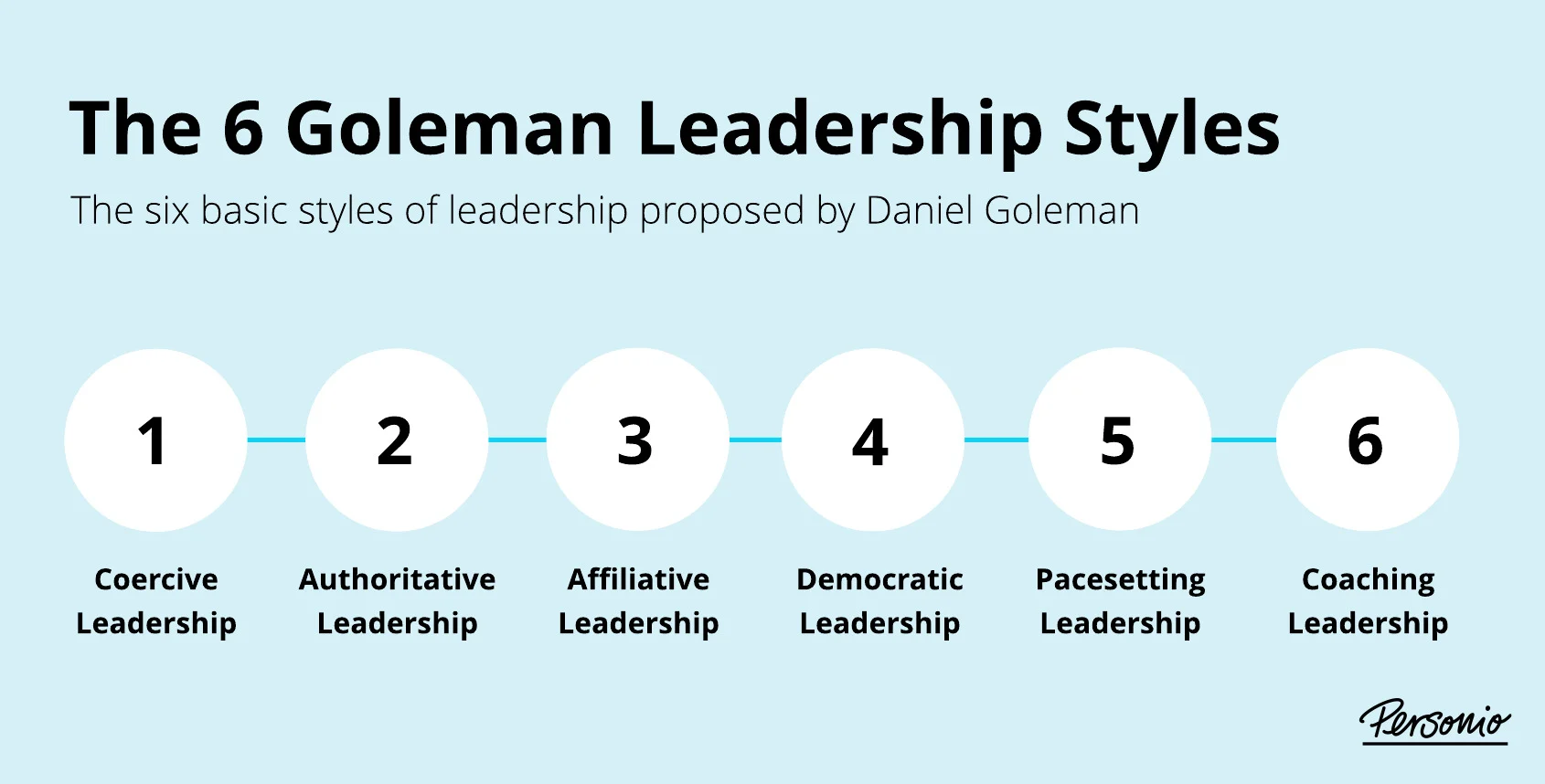
Are you stuck in an endless loop of time-consuming tasks?
Learn how to take HR from process to purpose.
Download NowThe 6 Goleman Leadership Styles: Which Is Yours?

In this article, we run through the six unique Goleman leaderships, why they matter for organisational excellence, and how you can harness the power of each (or help others do the same) to help take your team’s work to the next level.
Put performance in focus with our latest guide.
What Are The Goleman Leadership Styles?
The six Goleman leadership styles provide insight into a fundamental truth: Being the boss doesn’t always make you the leader.In workplaces where managers are competent but have poor interpersonal skills, employees are more likely to even consult their colleagues for advice.

The Goleman leadership styles come from Daniel Goleman, an author and psychologist whose research led him to establish the six basic styles of leadership based on different aspects of emotional intelligence. These include:
1. Coercive Leadership Style
Commonly referred to as "directive" or “commanding” leadership, it’s best to use coercive leadership when you need to fix a problem quickly and effectively. For example, dealing with a difficult employee or ‘putting out a fire’ at work.
2. Authoritative Leadership Style
You may know this one as “visionary” leadership. Authoritative leaders give their team a general direction and goal to achieve, but let them reach that goal in whichever way they deem appropriate.
3. Affiliative Leadership Style
An affiliative leader is all about the people. They want to create a positive work environment for their team members and are big on giving praise. The downside, though, is that the team rarely receives actionable advice or correction, leaving team members feeling confused and leaderless.
4. Democratic Leadership Style
Under democratic leadership (also known as “participative” leadership), every team member has a valued voice that management genuinely wants to hear from. These workplaces are typically more flexible and collaborative, but that comes with a price: Longer, more frequent meetings to discuss everyone’s opinions and hash out ideas.
5. Pacesetting Leadership Style
If you’re a pacesetting leader, you walk the walk and talk the talk daily. You know the importance of setting a good example for your team and having high standards for the work they produce.
6. Coaching Leadership Style
Much like its name suggests, coaching leaders focus on the personal development of their team members, rather than just meeting work-related quotas or sales goals. They work one-on-one with their employees to achieve excellence, which works well for employees who are open to improvement.
Does Goleman Suggest Choosing Only One Leadership Style?
According to Daniel Goleman, successful leaders don’t just stick to one leadership style; they’re well-versed in multiple styles and know-how — and when — to alternate between them depending on their circumstances.
For example, if your company was losing clients every day for weeks on end, you’d want a coercive leader to step in, take control of the situation and implement a fast-acting solution.
Once the fire is out, though, you’ll want to move forward with a leadership style, such as authoritative leadership, that can help you maintain positive client relationships through clear direction and goal setting.
How Do The Goleman Leadership Styles Impact Company Culture?
Looking at Goleman’s leadership styles, it’s clear to see which approaches build a positive company culture, and which weaken it:
Leaders who have a coaching, authoritative, affiliative or democratic style build positive cultures.
These leadership styles are much more open to collaboration. They put the employees first and value their opinions.
Leaders who only take a pacesetter or coercive approach often add to negative company culture.
Pacesetter or coercive leaders have their time and place but are often too intense or individualistic for daily workplace environments.
If you’ve ever worked in a less-than-positive workplace environment, you know how much negative leadership style can impact company culture. Even if you enjoy your job and get along with your coworkers, a poor leadership team can put you back on the job hunt.
On the flip side, a positive leadership team can make an otherwise monotonous job enjoyable. Leaders have a significant impact on not only how a workplace runs, but also how it feels:
Good Leadership Boosts Employee Satisfaction
Fifty-five per cent of employees believe that having trust with and in their senior management is very important to their feeling of job satisfaction. But, only 43% of UK employees positively trust their management. There’s a lot of work that can be done to build employee-leadership trust, improve overall satisfaction, and in turn, build a more positive workplace.
Good Leadership Increases Employee Retention
Leadership has a domino effect in the workplace: Poor leadership leads to bad employee experiences, which leads to a negative workplace culture, which leads to low employee retention.
So, what are employees looking for in a leader? According to them, the most common pitfalls of a leader are poor communication (62%), focusing too much on day-to-day issues (55%) and avoiding conflict (44%). Goleman’s research showed that successful leaders showed strengths in self-awareness, self-regulation, motivation, empathy and social skill. Be direct, open and have a clear vision for your team and company, and you’ll attract and retain like-minded workers.
Good Leadership Improves Productivity
By taking on one of the more positive leadership styles, you can motivate employees and get them aligned with your company’s mission through genuine enthusiasm and buy-in.
When you open up communication and coach your team, you help them overcome obstacles quickly so they can get back to work confidently.
Good Leadership Drives Revenue
Toxic company culture, which is often a ripple effect of toxic leadership, costs the UK economy £15.7 billion per year. Simply put, your team’s work performance and outcomes will improve when their leaders positively impact their lives.
Workers are also more likely to provide better customer service when they genuinely believe in the work they’re doing and are supported to achieve their best.
How Can HR Help Best Manage These Various Leadership Styles?
Each of the Goleman leadership styles has its own strengths and weaknesses. Knowing how to manage the different styles starts with understanding their pros and cons and what type of support each type of leader may need:
Managing A Coercive Leader
Where They Shine | What Can Go Wrong | What You Can Do |
|---|---|---|
Coercive leadership should be used the least often out of all the leadership styles. These leaders do best in emergency or high-pressure situations where tough decisions have to be made quickly, and no other leadership style will work. | Coercive leaders can have the worst impact on morale. They often come in swinging to fix situations without listening to others. This leads to employees feeling uncomfortable approaching their leader with ideas or bringing up issues, or feeling a sense of loss over their work ownership. | Ensure coercive leadership is only used when absolutely necessary and develop a leadership plan for after the fire has been put out. Check in with team members to make sure they’re being heard and supported during turbulent times. |
Managing An Authoritative Leader
Where They Shine | What Can Go Wrong | What You Can Do |
|---|---|---|
Authoritative leadership is the most effective of the six styles. They have a clear vision for their company and make everyone feel like they play an important role in the company’s mission. | Authoritative leaders can become too overbearing while driving their team members to achieve certain goals. | Make sure team members maintain autonomy in their work, are rewarded for their achievements, and that their leader remains focused on the larger picture. |
Managing An Affiliative Leader
Where They Shine | What Can Go Wrong | What You Can Do |
|---|---|---|
If your company needs to boost its morale or improve its culture, affiliative leadership is your best bet. These leaders are great at building relationships and creating collaborative and open environments where communication and inspiration thrive. They give constant praise and positive feedback and are regularly booking one-on-one meetings and team outings. | Affiliative leaders will often avoid giving their team members difficult feedback or advice, and will only deliver praise, which can stifle their employees’ growth. | An affiliative leader needs balance. Use this approach in conjunction with an authoritative style so your team receives positive feedback while keeping their eyes on the prize. |
Managing A Democratic Leader
Where They Shine | What Can Go Wrong | What You Can Do |
|---|---|---|
By getting their team involved in decisions and making sure their team members’ voices are heard, democratic leaders build trust and respect in their company. This leadership style works best when the leader needs advice and trusts their team, but shouldn’t be used in emergencies or high-stakes scenarios. | Too many meetings can decrease productivity and burn out employees. Democratic leaders can also lose authority and trust if they’re constantly asking for advice without making a final decision on the matter. | Help democratic leaders strike a balance between giving a voice to their valued team members and maintaining authority and control. Limit the number or length of meetings so teams can stay productive. |
Managing A Pacesetting Leader
Where They Shine | What Can Go Wrong | What You Can Do |
|---|---|---|
A pacesetting leader does their best work when they have a team of self-motivated experts who don’t need a lot of direction. They need to have proven trust in their team. | A pacesetting leader can often set the bar so high that employees feel overwhelmed or unable to meet unrealistic standards. This can lead to pacesetters taking control over situations more often than they should, adding more to their own plate while weakening employee’s trust and autonomy. | Like coercive leadership, the pacesetting approach should be used sparingly. Make sure the leader’s goals are attainable, realistic, and clearly communicated to their team. |
Managing A Coaching Leader
Where They Shine | What Can Go Wrong | What You Can Do |
|---|---|---|
When you have a team or employee with potential, a coaching leader can help them identify their strengths and reach their goals. They’re encouraging, give plenty of feedback and help build a positive company culture. | This style is rarely used because leaders don't have the time required to effectively coach their employees. If a leader is impatient or short on time, their attempt at coaching can seem disingenuous, rushed or unproductive. | Give coaching leaders and their teams the time and resources they need to make the experience a success. Help them develop a long-term plan, schedule one-on-one meetings together and set achievable goals. |
The Importance Of Developing A Well-Rounded Leadership Style
As author Simon Sinek says, “A boss has the title, a leader has the people”.
While some leaders may naturally follow one of Goleman’s six leadership styles, they should also learn how to master the others. This way, they can use each style to its full potential while building a positive workplace culture.

